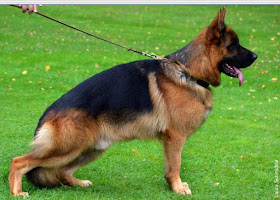Pages
▼
Friday, September 7, 2018
HD Manipulation by Feetback Kennel Has Stirred up a Storm
Inheritance of Canine Hip Dysplasia in GSD
A recent news about HD manipulation by Feetback Kennel has stirred up a storm on the Internet. The news reported by GSD World News stated, “Due to several inquiries, news and some comments, a little explanation on the subject of such claims against the Kennel Feetback. The owner of said specimen, said in response of the dog Lampio di Serbio Feetback claiming that it has fallen victim to the fraudulent tactic of HD manipulation.” He further went on to explain that he bought the dog at the age of 12 months. At the time, HD / ED and DNA (in Germany) were already registered with the SV and elbows were rated as "normal" and the hips as "almost normal". There followed a lot of work and success, because in the end he completed the prestigious IPO 3 licensing on lifetime. But after receiving the letter from the SV, he submitted the x-ray to the centre to satiate their assumption that the dog may be a victim of HD manipulation.”
The owner claimed, that the health of his dog is personally (even if not in the interests of the blamed breeder) very important for him. The news that arrived a few weeks later, clearly stating – HD Manipulation, shocked him. The disappointed owner wrote on GSD World News’ social media page as – "Sg 2" Onar Feetback has been manipulated”. He highlights this as a socio-economic problem that “is gear and fabric in the Serbian breeding of Dejan Simovic, Goran Pesic and Miodrag Stojancevic!”
Unscrupulous activities like this is a serious threat to the breed!
Understanding the inheritance rate of CHD:
Dysplasia is a complex polygenic disorder that is not congenital in nature. The phenotypic expression of CHD is also linked with environmental factors. Even dogs with normal phenotypes maybe carriers as it is a complex polygenic disorder and control of passing on of said genes would increase the selection pressure on the breeders. It is sad to note, that due to unethical practices when considering breeding partners (where genomic breeding values should be prioritized). This is the only control system to take this trait off the breeding line has often been ignored or manipulated as the case reported above. Selection pressure on the breeders may be burdensome but is for the good of the species when they consider genomic breeding values over aesthetic counterparts.
The best possible solution of controlling the inheritance of this potentially debilitating condition is through selection of dogs with better individual phenotypes when breeding. In a polygenic disease, different genes contribute small yet substantial additive effects that manifests into the disease. But in case of CHD, environmental as well as other factors such as age, sex, body weight of specimen and the conditioning during the first 60 days of a pup’s life is said to influence the hip joint formation and expression of the disease. Molecular studies to understand the manifestation and genetic basis of CHD has been going on for several years now. But hasn’t returned any substantial progress due to low interest from concerned communities.
However, the published inheritance rate of CHD traits is variable and reportedly range between 0.1 to 0.60. The differences of inheritance rate estimations depend on the trait considered, calculation methods used, selection, and the population and sample used for estimation. For example, the heritability is seen to be as high as 0.83 in case of passive hip laxity in the Estrela Mountain breed of dogs from Portugal. Thus, it safe to conclude that the genetic improvements after stringent selection of traits of those with higher inheritance rates, will accumulate over time. And if such malpractices are continued for personal gains of breeders, then the selection pressures for breeders will be bigger per generation and be corrosive to the health and welfare of the species we love.
As lovers of dogs we must promote the idea of selection and breeding of specimens with low hip scores to control and reduce the incidence of hip dysplasia.
Author bio:
Pritha Biswas is an independent researcher and published science and research non-fiction writer and editor, with a background in Zoological sciences presently working on understanding the behavior and breeding nuances of German Shepherd dogs with an outsider outlook. Copying and re-publishing this article is subject to a written permission sought from Pritha Biswas and Aringsburg via email aringsburg(at)gmail.com


No comments:
Post a Comment